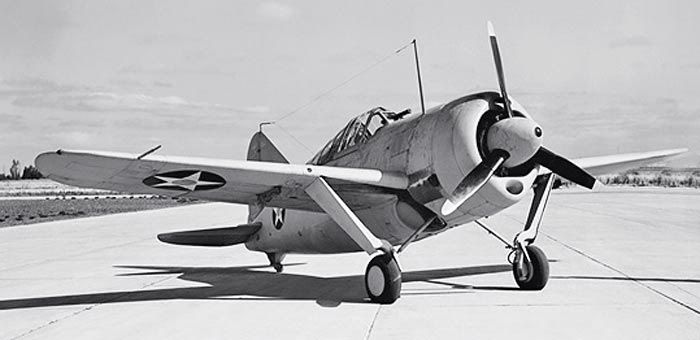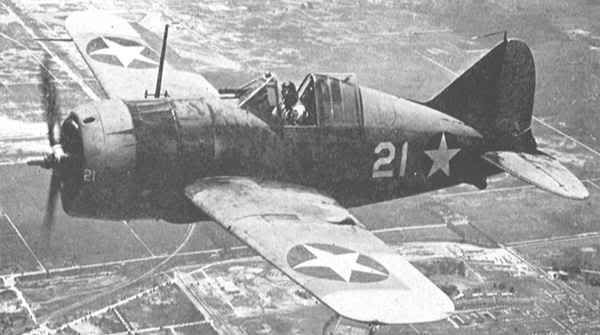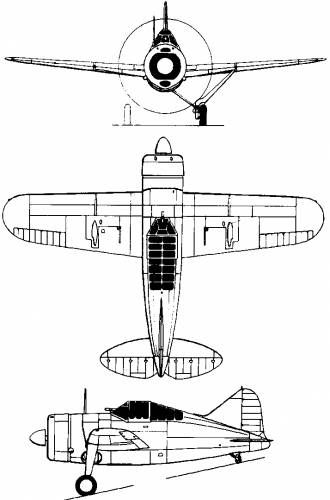
 |
|
|||||||
| IL-2 Sturmovik: Birds of Prey Famous title comes to consoles. |
 |
|
|
Thread Tools | Display Modes |
|
|
|
#1
|
|||
|
|||
|
Nice idea. You can edit the first post and include a plane list that we know
Watched in Trailer Brewster F2A Buffalo General characteristics Crew: One, pilot Length: 26 ft 4 in (8.03 m) Wingspan: 35 ft 0 in (10.67 m) Height: 12 ft 0 in (3.66 m) Wing area: 209 ft² (19.4 m²) Empty weight: 4,732 lb (2,146 kg) Max takeoff weight: 7,159 lb (3,254 kg) Powerplant: 1× Wright R-1820-40 Cyclone 9 nine-cylinder single-row air-cooled radial engine, 1,200 hp (895 kW) Performance Maximum speed: 321 mph (279 knots, 517 km/h) at 16,500 ft (5,030 m) Cruise speed: 161 mph (140 knots, 259 km/h) Range: 965 mi (839 nmi, 1,554 km) Service ceiling: 33,200 ft (10,600 m) Rate of climb: 2,440 ft/min[N 9] (744 m/min) Armament Guns: 2 × 0.50 in (12.7 mm) nose-mounted M2 machine guns 2 × 0.50 in (12.7 mm) wing-mounted machine guns The Brewster F2A Buffalo was an American fighter aircraft which saw limited service early in World War II. Though the Buffalo won a competition against the Grumman F4F Wildcat in 1939 to become the US Navy's first monoplane fighter aircraft, it turned out to be a big disappointment. Several nations, including Finland, Belgium, Britain and the Netherlands, ordered the Buffalo to bolster their struggling air arms, but of all the users, only the Finns seemed to find their Buffalos effective, flying them in combat with excellent results.[1] During the Continuation War of 1941–1944, the B-239's (a de-navalized F2A-1) operated by the Finnish Air Force proved capable of engaging and destroying most types of Soviet fighter aircraft operating against Finland at that time, achieving, in the first phase of that conflict, a kill-ratio of 32:1, 32 Soviet aircraft shot down for every B-239 lost[2] and producing 36 Buffalo "aces".[3] When World War II began in the Pacific[4] in December 1941, Buffalos operated by both British Commonwealth (B-339E) and Dutch (B-339D) air forces in South East Asia suffered severe losses in combat against the Japanese Navy's Mitsubishi A6M Zero and the Japanese Army's Nakajima Ki-43 "Oscar". The British attempted to lighten their Buffalos by removing ammunition and fuel and installing lighter guns in order to increase performance, but it made little difference.[4] The Buffalo was built in three variants for the U.S. Navy, the F2A-1, F2A-2 and F2A-3. (In foreign service, with lower horsepower engines, these types were designated respectively, B-239, B-339, and B-339-23.) The F2A-3 variant saw action with United States Marine Corps (USMC) squadrons at the Battle of Midway. Shown by the experience of Midway to be no match for the Zero, the F2A-3 was derided by USMC pilots as a "flying coffin."[5] The F2A-3, however, was significantly inferior to the F2A-2 variant used by the Navy before the outbreak of the war. source: Wikipedia   
|
|
#2
|
|||
|
|||
|
Quote:
Panzergranate will be in his element when he see's this!! haha. |
|
#3
|
||||
|
||||
|
Quote:
lol If you read this Panzer, we love you really. Wouldn't be the same without you
__________________
 XBL GT: - Robotic Pope HyperLobby CS: - Robot_Pope |
|
#4
|
|||
|
|||
|
Quote:
|
|
#5
|
||||
|
||||
|
I am going to go out on a limb and "assume" that BoS and World of Planes will have the same inventory of ac. so that being said i saw 4 more planes.
P38 Lightning The Lockheed P-38 Lightning is a twin-engined single-seat fighter and fighter bomber aircraft produced by the US-American manufacturer Lockheed Corporation. Reconaissance variants of the P-38 were designated F-4 & F-5 Lightning. Crew 1 Propulsion 2 Piston Engines Engine Model Allison V-1710-113 Engine Power (each) 1100 kW 1475 hp Speed 667 km/h 360 kts 414 mph Service Ceiling 13.411 m 44.000 ft Range 1.771 km 956 NM 1.100 mi. Empty Weight 5.806 kg 12.800 lbs max. Takeoff Weight 9.798 kg 21.600 lbs Wing Span 15,85 m 52,0 ft Wing Area 30,4 m² 327 ft² Length 11,53 m 37,8 ft Height 3,91 m 12,8 ft First Flight 27.01.1939 Production Status out of production Total Production 10037 ICAO Code P38 FAA TCDS LTC-10 Data for (Version) Lockheed P-38L Lightning Variants P-38, P-38D, P-322, P-38E, P-38F, P-38G, P-38H, P-38J, P-39K, P-38L, P-38M, F-4 (P-38E), F-5A (P-38G), F-5B (P-38J)
__________________

|
|
#6
|
||||
|
||||
|
he PBY Catalina flying boat
Bomber / Maritime Patrol Aircraft The Consolidated PBY Catalina is a twin-engined multi-role flying boat or amphibious aircraft produced by the US-American manufacturer Consolidated Aircraft Corporation. Crew 8 Propulsion 2 Radial Engines Engine Model Pratt & Whitney R-1830-92 Twin Wasp Engine Power (each) 895 kW 1200 hp max. Cruise Speed 200 km/h 108 kts 124 mph max. Speed (vne) 315 km/h 170 kts 196 mph Service Ceiling 4.816 m 15.800 ft Rate of climb 305 m/min 1000 ft/min Range 4.030 km 2.176 NM 2.504 mi. Empty Weight 9.485 kg 20.911 lbs max. Takeoff Weight 16.066 kg 35.419 lbs Wing Span 31,70 m 104,0 ft Wing Area 130,1 m² 1400 ft² Length 19,46 m 63,8 ft Height 6,15 m 20,2 ft First Flight 28.03.1935 Production Status out of production Production Range 1936-1945 Total Production >4000 ICAO Code CAT FAA TCDS 2-548, AR-22 Data for (Version) Consolidated PBY-5A Catalina Variants Consolidated PBY-1, PBY-2, PBY-3, PBY-4, PBY-5, PBY-5A, PBY-6A, OA-10, OA-10A, OA-10B, Catalina Mk I, Mk IA, Mk IB, Mk II, Mk IIA, Mk IIIA, Mk IVA, GR.Mk IVB, ASR.Mk IVB, GR.Mk VI, Remarks The PBY Catalina was produced in several variants by Consolidated, Naval Aircraft Factory, Canadian Vickers, Boeing Canada and in Russia. The early produced variants were flying boats whereas the later variants were amphibious aircraft with retractable landing gear.
__________________

|
|
#7
|
||||
|
||||
|
the Bristol Beaufighter
Fighter Bomber / Torpedo Bomber The Bristol 156 Beaufighter is a twin-engined two-seat heavy fighter aircraft produced by the British manufacturer Bristol Aeroplane Company. The Beaufighter served also as a fighter bomber and torpedo bomber aircraft. Crew 2 Propulsion 2 Radial Engines Engine Model Bristol Hercules XVII Engine Power (each) 1286 kW 1725 hp Speed 515 km/h 278 kts 320 mph Service Ceiling 5.791 m 19.000 ft Range 2.254 km 1.217 NM 1.401 mi. Empty Weight 7.072 kg 15.592 lbs max. Takeoff Weight 11.521 kg 25.400 lbs Wing Span 17,63 m 57,8 ft Wing Area 46,7 m² 503 ft² Length 12,70 m 41,7 ft Height 4,83 m 15,8 ft First Flight 17.07.1939 Production Status out of production Total Production 5926 Developed from Bristol 152 Beaufort Data for (Version) Bristol 156 Beaufighter TF.Mk.X Variants Beaufighter Mk IF, Mk IC, Mk II, Mk IIF, Mk VI, Mk VIC, Mk VIF, TF Mk X, Mk XIC, Mk 21 (DAP Beaufighter), TT Mk 10 Remarks The Bristol Beaufighter is a development of the Bristol Beaufort. The Beaufighter Mk.21 was also license-built by the Australian Department of Aircraft Production (DAP) as a fighter bomber and torpedo bomber aircraft.
__________________

|
|
#8
|
||||
|
||||
|
Another plane i have history with...
The Me 262 Fighter The Messerschmitt Me 262 is a two-engined multi role jet fighter aircraft produced by the German manufacturer Messerschmitt AG. Developed in world war II for the German Luftwaffe of the Third Reich, the Me 262 was operational as a fighter, night fighter, interceptor, fighter bomber and as a reconnaissance aircraft. Crew 1 Propulsion 2 Turbojet Engines Engine Model Junkers Jumo 004B-1 Engine Power (each) 8,8 kN 1978 lbf Speed 870 km/h 470 kts 541 mph Service Ceiling 11.450 m 37.565 ft Rate of climb 1189 m/min 3900 ft/min Range 1.050 km 567 NM 652 mi. Empty Weight 3.800 kg 8.378 lbs max. Takeoff Weight 6.400 kg 14.110 lbs Wing Span 12,48 m 40,9 ft Wing Area 21,7 m² 234 ft² Length 10,60 m 34,8 ft Height 3,84 m 12,6 ft First Flight 18.04.41 (Jet 25.03.42) Production Status out of production Production Range 1943 - 1945 Total Production ca. 1430 ICAO Code ME62 Data for (Version) Messerschmitt Me 262A-1a Remarks The Messerschmitt Me 262 was the world's first operational jet fighter aircraft. The fighter variants were called Schwalbe (swallow), the fighter bomber variant Sturmvogel (petrel).
__________________

|
|
#9
|
|||
|
|||
|
Quote:
|
|
#10
|
||||
|
||||
|
pope found this comment:
Hundreds of planes in one game More than 100 models of planes, participated in air battles of war with hundreds of planes in each combat. The player can choose the side and upgrade or buy new planes for Germany (from early Bf-109 till early jets), USSR (including jet BI-1), RAF (from Spitfires to Gloster Meteor), Japan and USA. SO.... I will now add those 2 AC as well. the Gloster Meteor G.41 Meteor Fighter The Gloster Meteor is a twin-engined single-seat jet fighter aircraft produced by the British manufacturer Gloster Aircraft. Crew 1 Propulsion 2 Turbojet Engines Engine Model Rolls-Royce Derwent 8 Engine Power (each) 15,6 kN 3500 lbf Speed 965 km/h 521 kts 600 mph Service Ceiling 13.106 m 43.000 ft Range 965 km 521 NM 600 mi. Empty Weight 4.846 kg 10.684 lbs max. Takeoff Weight 7.121 kg 15.700 lbs Wing Span 11,32 m 37,1 ft Wing Area 32,5 m² 350 ft² Length 13,59 m 44,6 ft Height 3,96 m 13,0 ft First Flight 05.03.1943 Production Status out of production Total Production 3947 Data for (Version) Gloster Meteor F Mk8 Variants Meteor F.1, F.3, F.4, T.7, F.7, FR.9, PR.10, NF.11, NF.12, NF.13, NF.14, TT.20 Remarks The Gloster Meteor was the first operational British jet fighter aircraft and the only Allied jet fighter to see combat in WWII. i think we will have the opportunity to have some very interesting games...bi-plane dogfights and jet vs jet....cool.
__________________

|
 |
| Thread Tools | |
| Display Modes | |
|
|